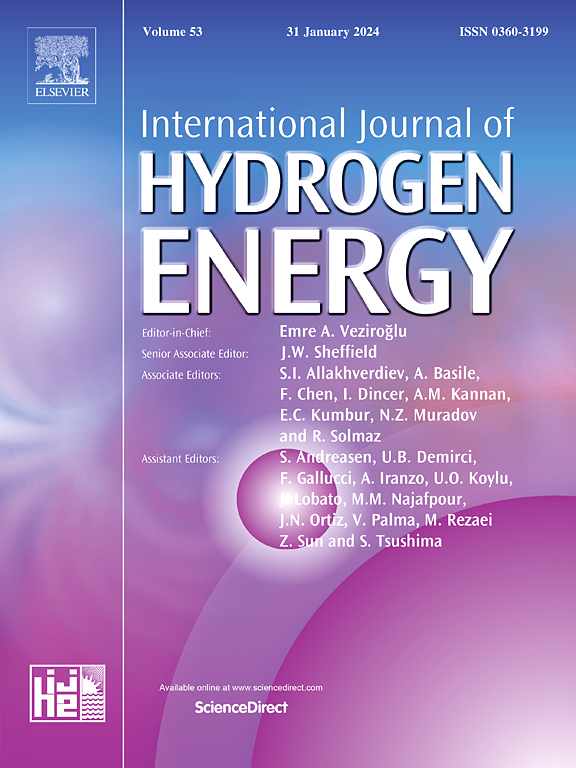置换负电性元素缺陷诱导硅烯电子结构改性,使其成为用于水分离的高性能阴极材料
IF 8.1
2区 工程技术
Q1 CHEMISTRY, PHYSICAL
引用次数: 0
摘要
全球日益增长的能源需求和环境问题凸显了对创新型绿色可持续能源转换技术的需求。水分裂是一种先进的绿色制氢方法,它具有极高的能量密度和零碳排放,可大大缓解环境污染和危机。本研究探讨了通过涉及电负性元素(P、Se、S 和 C)的置换缺陷来改变硅烯的电子结构,从而提高其作为氢进化反应(HER)阴极材料的功效。密度泛函理论(DFT)模拟显示,缺陷诱导的修饰显著改变了硅烯的电子结构,优化了活性位点。在各种构型中,SiC3-硅烯是一种优异的催化剂,其氢进化反应的吉布斯自由能(ΔGH)达到了前所未有的 0.008 eV,超过了传统的铂基催化剂。此外,在电流密度为 500 mA/cm2 时,SiC3-硅烯的过电位仅为 172 mV,这肯定了它在工业规模应用方面的潜力。一项全面的电荷转移分析表明,电负性掺杂剂的加入引起了大量的电荷再分布,显著提高了活性位点的电荷浓度。电荷转移的增强在稳定氢吸附方面发挥了关键作用,从而提高了催化效率。此外,掺杂硅烯的结构稳定性证实,SiC3-硅烯构型能保持稳健的结构完整性,这对实际应用至关重要。这项基于模拟的研究将 SiC3-硅烯作为一种新型、高性能的阴极材料用于可持续制氢,为其在可持续能源系统中的实际应用铺平了道路。本文章由计算机程序翻译,如有差异,请以英文原文为准。
Substitutional electronegative element defects-induced modification of silicene's electronic structures as high-performance cathode material for water splitting
The growing global energy demands, and environmental concerns underscore the need for innovative green and sustainable energy conversion technologies. Water splitting, an advanced method for green hydrogen production, offers exceptional energy density with zero carbon emissions, and can significantly alleviate environmental pollution and crisis. This study explores the modification of silicene's electronic structure through substitutional defects involving electronegative elements (P, Se, S, and C) to enhance its efficacy as a cathode material for the hydrogen evolution reaction (HER). Density functional theory (DFT) simulations reveal that defect-induced modifications significantly alter the electronic structure of silicene, optimizing active sites. Among the various configurations, SiC3-silicene emerges as a superior catalyst, exhibiting an unprecedented Gibbs free energy (ΔGH) of 0.008 eV for HER, surpassing the performance of traditional platinum-based catalysts. Furthermore, SiC3-silicene demonstrates a minimal overpotential of 172 mV at current densities of 500 mA/cm2, affirming its potential for industrial-scale applications. A comprehensive charge transfer analysis shows that the incorporation of electronegative dopants induces substantial charge redistribution, markedly increasing charge concentration at the active sites. This enhanced charge transfer plays a pivotal role in stabilizing hydrogen adsorption, thereby improving catalytic efficiency. Additionally, the structural stability of doped silicene confirms that the SiC3-silicene configuration maintains robust structural integrity, which is essential for practical deployment. This simulation-based study introduces SiC3-silicene as a novel, high-performance cathode material for sustainable hydrogen production, paving the way for its practical implementation in sustainable energy systems.
求助全文
通过发布文献求助,成功后即可免费获取论文全文。
去求助
来源期刊

International Journal of Hydrogen Energy
工程技术-环境科学
CiteScore
13.50
自引率
25.00%
发文量
3502
审稿时长
60 days
期刊介绍:
The objective of the International Journal of Hydrogen Energy is to facilitate the exchange of new ideas, technological advancements, and research findings in the field of Hydrogen Energy among scientists and engineers worldwide. This journal showcases original research, both analytical and experimental, covering various aspects of Hydrogen Energy. These include production, storage, transmission, utilization, enabling technologies, environmental impact, economic considerations, and global perspectives on hydrogen and its carriers such as NH3, CH4, alcohols, etc.
The utilization aspect encompasses various methods such as thermochemical (combustion), photochemical, electrochemical (fuel cells), and nuclear conversion of hydrogen, hydrogen isotopes, and hydrogen carriers into thermal, mechanical, and electrical energies. The applications of these energies can be found in transportation (including aerospace), industrial, commercial, and residential sectors.
 求助内容:
求助内容: 应助结果提醒方式:
应助结果提醒方式:


